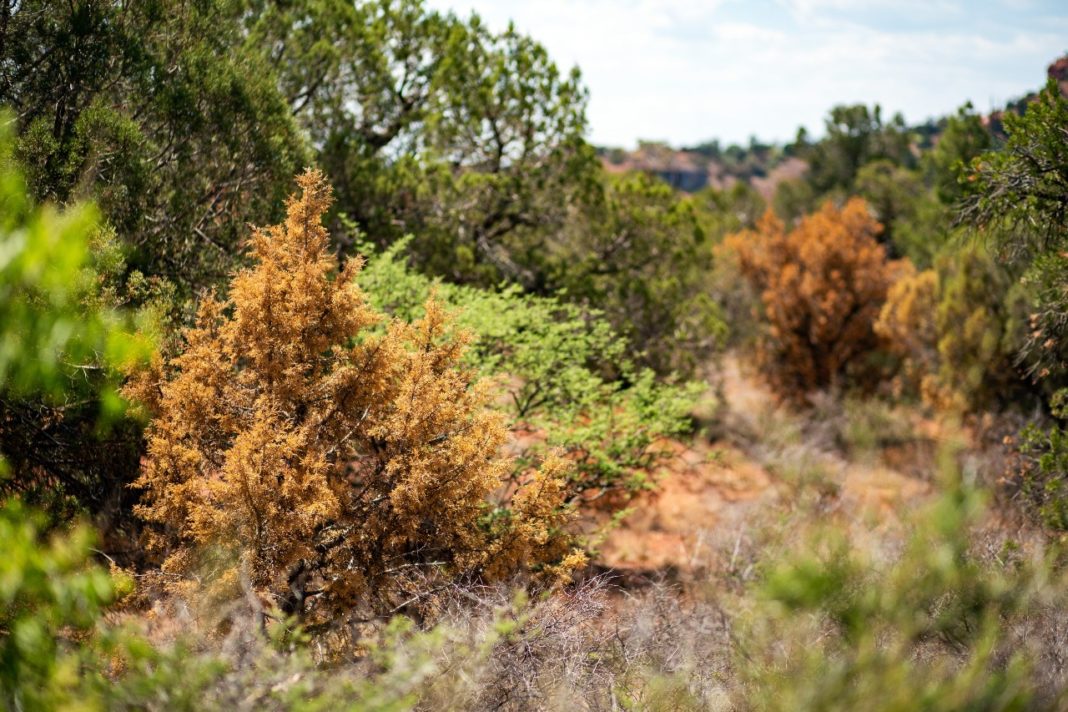The intense drought of the last two years is taking a toll on the region’s drought-adapted native trees and bushes.
Jeff Schalau, Yavapai County director for the University of Arizona’s Cooperative Extension, said the county’s master gardener office has fielded numerous calls this year from homeowners and organizations about browning junipers, pines, cypresses and other plants on their properties.

In March, Prescott National Forest issued a press release stating that a survey in February found a 10-fold increase in ponderosa mortality since August of 2020.
Driving around Sedona, browning trees are not difficult to spot from car windows. The Little Horse Trailhead is just one area where numerous brown, crispy trees can be seen.
According to Schalau, the last time he saw this many trees succumbing to drought and native bark beetles was 2002, a historically dry year in Arizona.
That year Agriculture Secretary Ann M. Veneman designated the entire state of Arizona as a drought disaster area. Coconino National Forest closed for nine weeks due to fire danger.
A forest ranger told the Arizona Republic at the time, “Douglas fir trees are beginning to die of a lack of water, and even drought-resistant trees such as junipers and piñon pines are starting to show stress.”
That’s what Schalau and other local plant specialists are seeing this year.
Schalau said that many of the native trees, especially ponderosa and Arizona cypress, are dying from native bark beetle infestations, which increase during hot and dry conditions.
But in some cases, plants may be succumbing to dryness alone.
The tree species most-affected by the dryness varies by area. Around Sedona, Schalau said junipers appear to be particularly affected by the recent dry conditions. In Prescott, many ponderosas are dying.
Advice from a Horticulturist
Dan Smith, director of horticulture at Sky Ranch Lodge, gave the follow tips for keeping plants drought-resistant and healthy:
■ Educate oneself on the specifics of individual plant needs and choose varieties for the desired outcome.
■ Hydrozoning is the practice of grouping plants with similar water needs together, helping to conserve water.
■ Build soil structure and top dress with compost and mulch to aid in water retention.
■ Water trees and shrubs deeply to encourage an extensive root system.
■ Avoid heavy pruning during high temperatures to avoid evaporation and added stress.
Schalau noted that in Sedona there can be wide variations in soil depths, due to the region’s geologic conditions, meaning that the drought can affect individual trees in very different ways, depending on the soil characteristics in a particular area.
Schalau was bracing for more calls about flagging trees last year, but he said many trees were able to hang in until now. Two years of missing monsoons and a historically dry winter is beginning to show on a larger number of native plants.
Global warming is increasing the intensity of droughts locally. A report from the Climate Assessment for the Southwest — a collaboration between the University of Arizona and New Mexico State University — predicts drops in winter and spring precipitation ranging up to 10% and 30%, respectively.
Schalau is philosophical about the tree loss this year, seeing periodic die offs as a natural part of the ecosystem.
For Schalau, there is even a silver lining, in that other native plants may move in to replace the junipers, which tend to dominate.
“In juniper stands [a community of trees] there’s less diversity,” he said. “Their dying may open the way for other plants.”
Hopefully, 2021 will see a wet monsoon, which will begin alleviating the stress on trees naturally.
If a property owner has a high-value native tree that is flagging in current conditions, Schalau said that supplemental watering may help the tree survive to wetter weather.
One technique he suggested is “to construct a berm at the tree’s dripline [the edge of the tree’s canopy] and fill it periodically with water. During critical periods, irrigate deeply [18 inches] twice a month during dry summer periods.”
The depth of irrigation can be tested using a metal probe.
Another way to irrigate trees is to coil a dripline out from the trunk of the tree to the tree’s dripline, and irrigate deeply, periodically.
Schalau said periodic watering is the best way to prevent beetle infestations. There are also some insecticides that are demonstrated to protect trees from beetles before colonization begins.
He added that homeowners should resist the impulse to fertilize trees that are struggling with drought — only water will help them.
Schalau noted that water conservation is a need in the region, and homeowners should use discretion and focus their attention on only the most important trees.






















